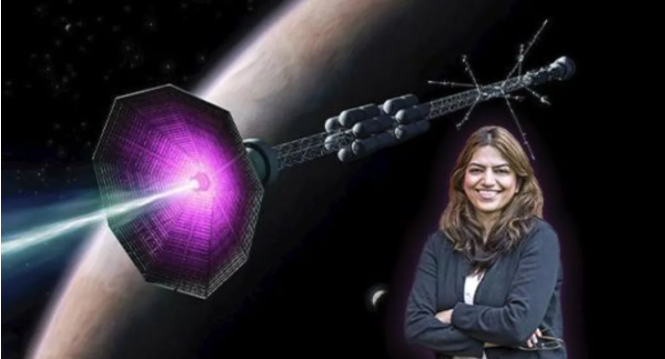By David
Szondy
January 31, 2021
Facebook
Twitter
Flipboard
LinkedIn

Fatima Ebrahimi
and an artist's concept of the magnetic reconnection plasma thruster in
operation (Photo credit:
VIEW 1 IMAGES
Over the past 64 years, there's
been remarkable success with robotic satellites and probes, but these have been
relatively small, with the heaviest being the ATV cargo ship weighing in at
44,738 lb (20,293 kg) fully loaded – and that one only went into low - Earth
orbit. The largest deep space probe was the Cassini - Huygens mission to Saturn,
which came in at a titchy 12,467 lb (5,655 kg).
This is because the greatest
obstacle to humanity becoming a true spacefaring species is the engines used to
propel spacecraft across the solar system and beyond. Chemical rockets can push
out an impressive amount of thrust, but have very little specific impulse. That
is, they can't fire for very long before they run out of propellant. Electric
propulsion systems, like Hall thrusters, are the opposite. They only put out
about as much thrust as the weight of a small coin, but they can burn for months
as opposed to minutes, so they can (slowly) build up to great speeds.
Unfortunately, neither is very
attractive for carrying astronauts to Mars aboard craft weighing tens, if not
hundreds, of tons. One might give a fast start and the other a slow one, but
they both mean a long, hazardous voyage of months, if not years. Both of these
basic propulsion approaches have their advantages and disadvantages, but what is
really needed, at least, in the short term, is one that combines properties of
the two. Ideally, something that has higher thrust and more specific impulse.
The new Princeton concept works
by using the same mechanism that helps to blast solar flares away from the Sun.
These flares consist of charged atoms and particles called plasma, which are
trapped inside powerful magnetic fields where complex interactions take place.
For propulsion systems, Ebrahimi
is particularly interested in one type of interaction called magnetic
reconnection, which is where magnetic fields in highly charged plasmas
restructure themselves to converge, separate, and re-converge. As they do so,
they generate large amounts of kinetic energy, thermal energy, and particle
acceleration. It's a phenomenon not only seen on the Sun, but also in the
Earth's atmosphere and inside Tokamak fusion reactors, like PPPL’s National
Spherical Torus Experiment (NSTX).
In a very general way, the
magnetic thruster is like the ion
thrusters that are becoming increasingly common on spacecraft. These work by
charging a propellant made up of heavy atoms like xenon and then accelerating
them using an electrical field. For the new concept thruster, the magnetic
fields do the accelerating.
So far, computer simulations by
PPPL computers and the National Energy Research Scientific Computing Center at
the Lawrence Berkeley National Laboratory in Berkeley, California, show that a
magnetic reconnection thruster could produce exhaust velocities 10 times faster
than that of current electric propulsion systems.
"Long-distance travel takes
months or years because the specific impulse of chemical rocket engines is very
low, so the craft takes a while to get up to speed," says Ebrahimi. "But if we
make thrusters based on magnetic reconnection, then we could conceivably
complete long-distance missions in a shorter period of time."
In addition to cutting down
travel time, the new thruster concept is throttlable by fine-tuning the magnetic
fields. In addition, the thrusters don't just shoot out plasma, but plasmoids,
which are balls of plasma contained in magnetic bubbles, adding more power.
Also, the thruster doesn't depend on heavy elements for propellant and can be
loaded with lighter, cheaper ones.
"While other thrusters require
heavy gas, made of atoms like xenon, in this concept you can use any type of gas
you want," Ebrahimi says.
The research was published in
the Journal
of Plasma Physics.
Source: PPPL